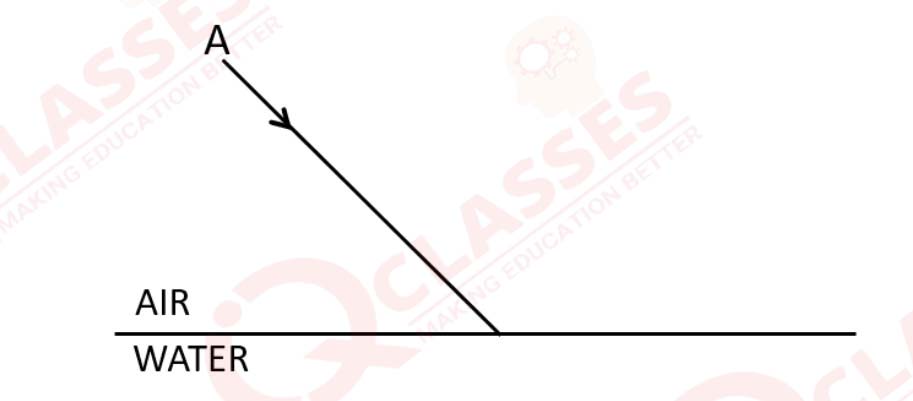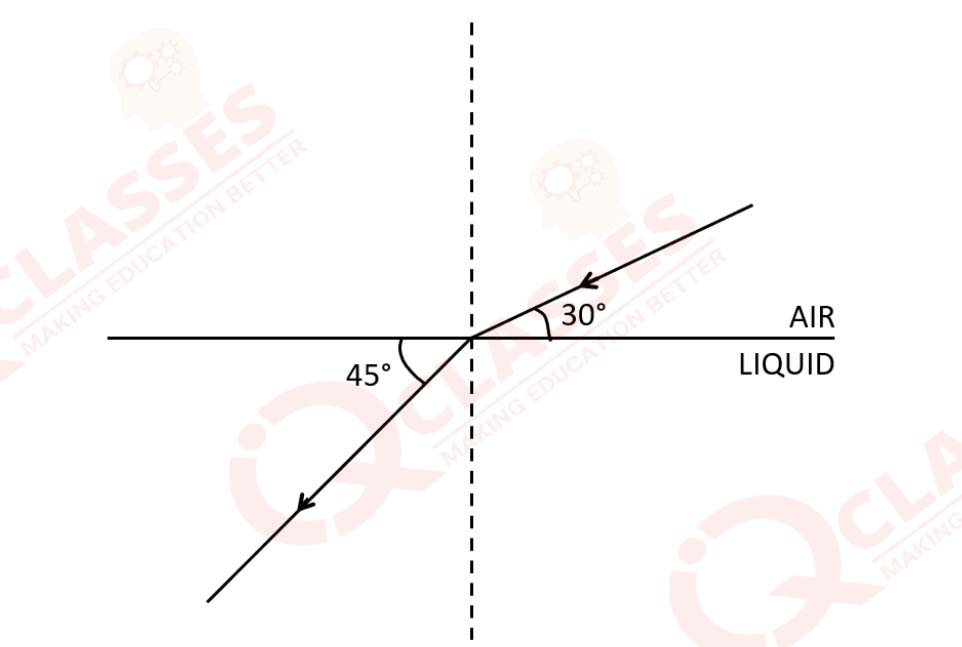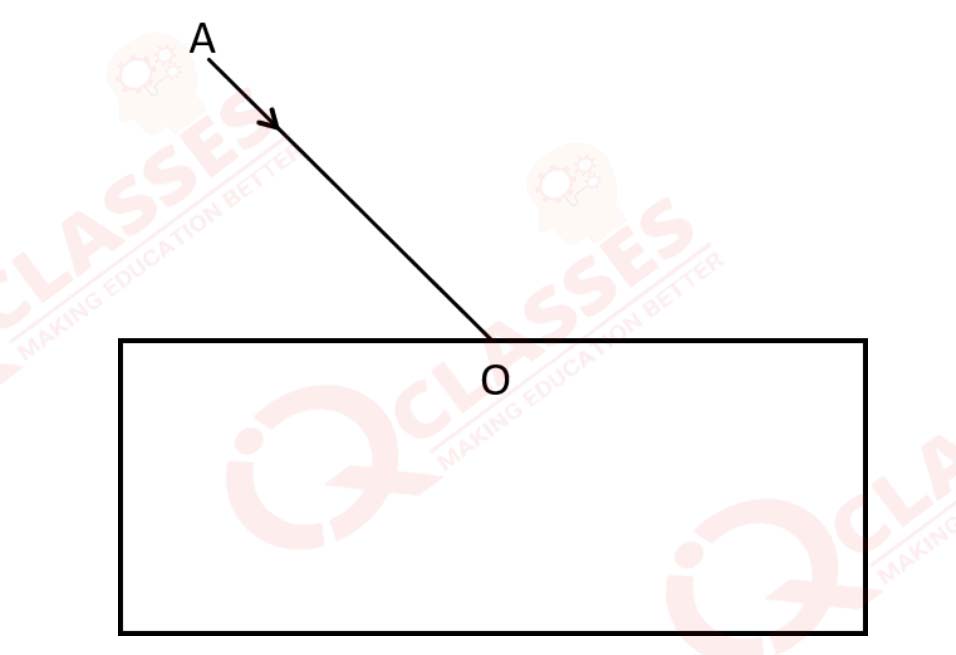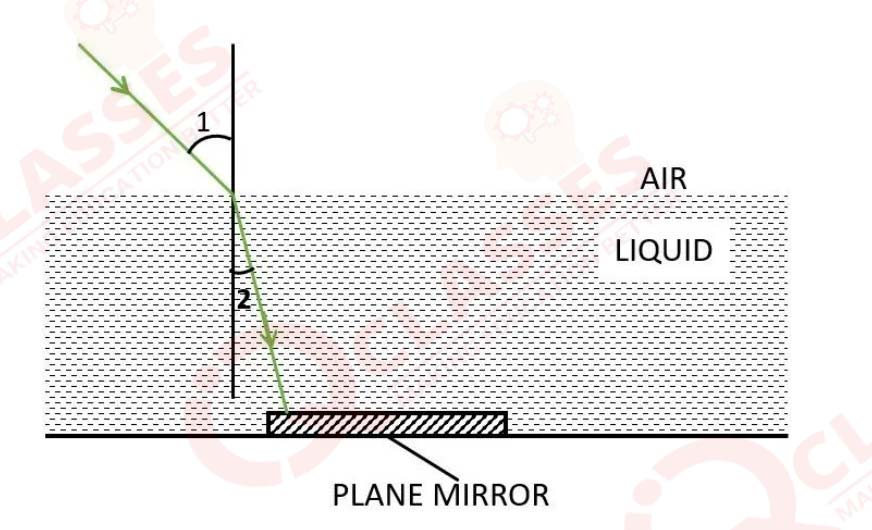Q1
What do you understand by refraction of light?
solutions
solutions

Q2
Draw diagrams to show the refraction of light from (i) air to glass, (ii) glass to air. In each diagram, label the incident ray, refracted ray, the angle of incidence (i) and the angle of refraction (r).
solutions
solutions

Q3
A ray of light is incident normally on a plane glass slab. What will be (i) the angle of refraction and (ii) the angle of deviation for the ray?
solutions
solutions

Q4
An obliquely incident light ray bends at the surface due to change in speed, when passing from one medium to other. The ray does not bend when it is incident normally. Will the ray have different speed in the other medium?
solutions
solutions

Q5
What is the cause of refraction of light when it passes from one medium to another?
solutions
solutions

Q6
A light ray suffers reflection and refraction at the boundary in passing from air to water. Draw a neat labelled diagram to show it.
solutions
solutions

Q7
A ray of light passes from medium 1 to medium 2. Which of the following quantities of the refracted ray will differ from that of the incident ray: speed, intensity, frequency and wavelength?
solutions
solutions

Q8
State the Snell’s laws of refraction of light.
solutions

solutions


Q9
Define the term refractive index of a medium. Can it be less than 1?
solutions
solutions

Q10
(a) Compare the speeds of light of wavelength 4000Å (i.e. violet light) and 8000Å (i.e. red light) in vacuum.
(b) How is the refractive index of a medium related to the speed of light in it and in vacuum or air?
solutions
solutions

Q11
A light ray passes from water to (i) air, and (ii) glass. In each case, state how does the speed of light change?
solutions
solutions

Q12
A light ray in passing from water to a medium (a) speeds up (b) slows down. In each case, (i) give one example of the medium, (ii) state whether the refractive index of medium is equal to, less than or greater than the refractive index of water.
solutions
solutions

Q13
What do you understand by the statement 'the refractive index of glass is 1.5 for white light'?
solutions

solutions


Q14
A monochromatic ray of light passes from air to glass. The wavelength of light in air is λ, the speed of light in air is c and in glass is V. If the refractive index of glass is 1.5, write down,
(a) the relationship between c and V,
(b) the wavelength of light in the glass.
solutions

(a) the relationship between c and V,
(b) the wavelength of light in the glass.
solutions


Q15
A boy uses blue colour of light to find the refractive index of glass. He then repeats the experiment using red colour of light. Will the refractive index be the same or different in the two cases? Give a reason to support your answer.
solutions
solutions

Q16
(a) For which colour of white light, is the refractive index of a transparent medium
(i) the least
(ii) the most?
(b) Which colour of light travels fastest in any medium except air?
solutions
(i) the least
(ii) the most?
(b) Which colour of light travels fastest in any medium except air?
solutions

Q17
Name two factors on which the refractive index of a medium depends? State how does it depends on the factors stated by you.
solutions
solutions

Q18
How does the refractive index of a medium depend on the wavelength of light used?
solutions
solutions

Q19
How does the refractive index of a medium depend on its temperature?
solutions
solutions

Q20
Light of a single colour is passed through a liquid having a piece of glass suspended in it. On changing the temperature of the liquid, at a particular temperature, the glass piece is not seen.
(i) When is the glass piece not seen?
(ii) Why is the light of a single colour used?
solutions
(i) When is the glass piece not seen?
(ii) Why is the light of a single colour used?
solutions

Q21
In the figure below, a ray of light A incident from air suffers partial reflection and refraction at the boundary of water.

(a) Complete the diagram showing (i) the reflected ray B and (ii) the refracted ray C.
(b) How are the angles of incidence i and refraction r related?
solutions

(a) Complete the diagram showing (i) the reflected ray B and (ii) the refracted ray C.
(b) How are the angles of incidence i and refraction r related?
solutions

Q22
The diagram alongside shows the refraction of a ray of light from air to a liquid.

(a) Write the values of (i) angle of incidence, and (ii) angle of refraction.
(b) Use Snell's law to find the refractive index of liquid with respect to air.
solutions

(a) Write the values of (i) angle of incidence, and (ii) angle of refraction.
(b) Use Snell's law to find the refractive index of liquid with respect to air.
solutions

Q23
The refractive index of water with respect to air is aμw and of glass with respect to air is aμg. Express the refractive index of glass with respect to water.
solutions
solutions

Q24
What is lateral displacement? Draw a ray diagram showing the lateral displacement of a ray of light when it passes through a parallel-sided glass slab.
solutions
solutions

Q25
A ray of light strikes the surface at a rectangular glass slab such that the angle of incidence in air is (i) 0°, (ii) 45°. In each case, draw a diagram to show the path taken by the ray as it passes through the glass slab and emerges from it.
solutions
solutions

Q26
In the adjacent diagram, AO is a ray of light incident on a rectangular glass slab.

(a) Complete the path of the ray until it emerges out of the slab.
(b) In the diagram, mark the angle of incidence (i) and the angle of refraction (r) at the first interface. How is the refractive index of glass related to angles i and r?
(c) Mark angle of emergence by the letter e. How are the angles i and e related?
(d) Which two rays are parallel to each other? Name them.
(e) Indicate in the diagram the lateral displacement between the emergent ray and the incident ray. State one factor that affects the lateral displacement.
solutions

(a) Complete the path of the ray until it emerges out of the slab.
(b) In the diagram, mark the angle of incidence (i) and the angle of refraction (r) at the first interface. How is the refractive index of glass related to angles i and r?
(c) Mark angle of emergence by the letter e. How are the angles i and e related?
(d) Which two rays are parallel to each other? Name them.
(e) Indicate in the diagram the lateral displacement between the emergent ray and the incident ray. State one factor that affects the lateral displacement.
solutions

Q27
A ray of green light enters a liquid from air, as shown in the figure. The angle 1 is 45° and angle 2 is 30°.

(a) Find the refractive index of liquid.
(b) Show in the diagram the path of the ray after it strikes the mirror and re-enters in air. Mark in the diagram the angles wherever necessary.
(c) Redraw the diagram if plane mirror becomes normal to the refracted ray inside the liquid. State the principle used.
solutions

(a) Find the refractive index of liquid.
(b) Show in the diagram the path of the ray after it strikes the mirror and re-enters in air. Mark in the diagram the angles wherever necessary.
(c) Redraw the diagram if plane mirror becomes normal to the refracted ray inside the liquid. State the principle used.
solutions

Q28
When an illuminated object is held in front of a thick plane glass mirror, several images are seen, out of which the second image is the brightest. Give reason.
solutions
solutions

Q29
Fill in the blanks to complete the following sentences —
(a) When light travels from a rarer to a denser medium, its speed ………………….
(b) When light travels from a denser to a rarer medium, its speed ………………….
(c) The refractive index of glass with respect to air is 3/2. The refractive index of air with respect to glass will be ………………….
solutions
(a) When light travels from a rarer to a denser medium, its speed ………………….
(b) When light travels from a denser to a rarer medium, its speed ………………….
(c) The refractive index of glass with respect to air is 3/2. The refractive index of air with respect to glass will be ………………….
solutions

Multiple Choice type Questions :
Q1
When a ray of light from air enters a denser medium, it:
1. bends away from the normal
2. bends towards the normal
3. goes undeviated
4. is reflected back
solutions
1. bends away from the normal
2. bends towards the normal
3. goes undeviated
4. is reflected back
solutions

Q2
A light ray does not bend at the boundary in passing from one medium to the other medium if the angle of incidence is:
1. 0°
2. 45°
3. 60°
4. 90°
solutions
1. 0°
2. 45°
3. 60°
4. 90°
solutions

Q3
The highest refractive index is of:
1. Glass
2. Water
3. Diamond
4. Ruby
solutions
1. Glass
2. Water
3. Diamond
4. Ruby
solutions

Numericals
Q1
The speed of light in air is 3 x 108 m s-1. Calculate the speed of light in glass. The refractive index of glass is 1.5.
solutions
solutions

Q2
The speed of light in diamond is 125,000 km s-1. What is the refractive index? (Speed of light in air = 3 x 108 m s-1).
solutions
solutions

Q3
The refractive index of water with respect to air is 4/3. What is the refractive index of air with respect to water?
solutions
solutions

Q4
A ray of light of wavelength 5400 Å suffers refraction from air to glass. Taking aμg = 3/2, find the wavelength of light in glass.
solutions
solutions
